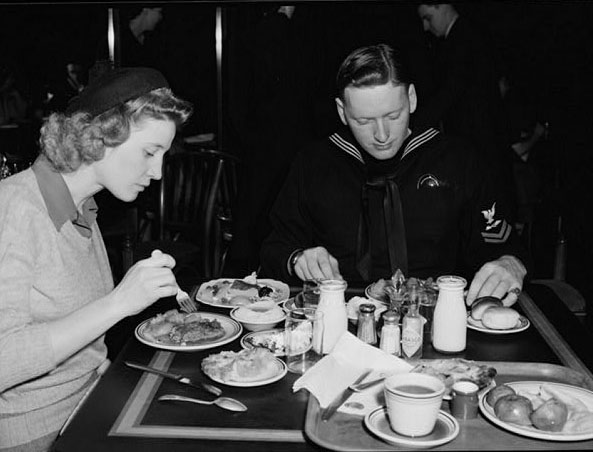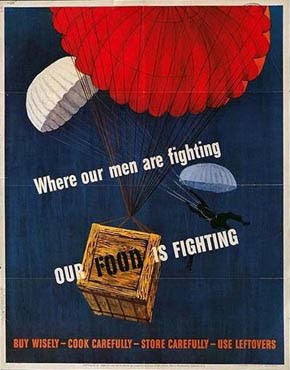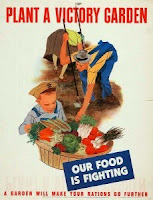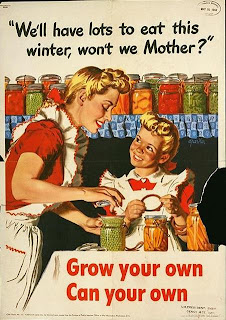...okay, maybe that should just read "Rationing is a gas!" since the whole idea is about using less, not more.
As I type there's around 75 days left until R-Day, the day my family begins living a lifestyle based on WWII rationing, or at least the modern equivalent. And one of the first components of our liv

es to be limited will be gasoline.
By mid-1942, most family automobiles had an "A" sticker in their window, indicating that their gasoline ration was at the low end of the scale - typically three to four gallons
per week during the war. Vehicles driven by personnel considered essential to the war effort were graced with a "B" sticker, earning eight gallons of gasoline per week. Industrial war workers fell within the "B" category. "C" stickers were for physicians, ministers, mail carriers and such whose jobs were considered critical to society. "T" stickers were reserved for trucks and other over-the-road transport while rare "X" stickers were for members of Congress and other elite VIPs. I haven't found specific gasoline allowance figures for the "C" and "T" stickers, but I know that they were higher than the "B" allotment, and "X" stickers earned the owner a basically un-rationed amount of gasoline.
Originally, the aim of gas rationing was to reduce the wear on tire rubber, since this natural resource (which was made from rubber trees now largely under Japanese control) was essential to the war effort. "Victory Speed" campaigns cropped up, touting lower traveling speeds (typically a max of 35 mph) to reduce tire wear and tear. However, most drivers ignored these limits (sounds stereotypically American, huh?).

So gas rationing was originally one prong of a two-pronged effort to redirect rubber away from citizen consumers so that more was available for military vehicles and supplies. How badly the rationing of gasoline effected Americans varied greatly based upon many factors including access to public transportation and proximity to essential locations such as employment and food markets. And while most cars in the 1940s averaged only 15-20 mpg (what we would call a "clunker" today), most individuals were not too far removed from their community centers to feel a dramatic crunch in their lifestyle (remember, this is before the days of urban sprawl and the death of rural towns). In fact, in late 1942 a whopping 95% of workers polled in Wichita, KS still drove their cars to work!
But this sure ain't the 1940s, and urban sprawl is definitely a reality in our modest-sized city (population of approximately 120,000). So, what does gasoline rationing mean for us? Well, first we had to consider some differences between the WWII scenario and today's lifestyle.
The range for miles per gallon in the 1940s was between 15 to 20, or roughly 17.5 mpg on average. Today, in the world of fuel-efficient economy models and hybrids the average is often 30+ mpg, which means our contemporary cars go farther than 1940s cars on the same gallon of gas (okay, not
quite the same gallon of gas...ours is
unleaded and contains ethanol). That comparison seems to suggest that following the exact same ticket allowances mentioned above might be too generous for our contemporary experiment.
But, you point out (really, I can hear you starting this line of thinking already), modern communities are so much more widespread in their distribution of resources that the sheer sprawl of a city requires one to drive farther for essential functions. For example, an individual in the 1940s typically drove (or walked) less than one or two miles to the grocery store; in today's communities a similar task may require four or five miles worth of travel
one way.

So keeping the same amount of rationed gasoline with our more fuel-efficient cars makes sense, no?
Well, this back and for, tit for tat comparison could go on endlessly - or at least until everyone involved has lost interest and chosen to drive 12 miles round trip for a mocha-brownie double scoop to get their minds off of such debate. So I'll spare you much of the conversation (the ice cream is up to you) and let you know the formula we settle upon for our year of rationing. Yup, it's a formula. I'm no math wiz, so hopefully I can explain it to you in a way that actually makes sense.
In our family my car would earn an "A" sticker, which unfortunately does not make me part of the A Team (I pity the fool!) but does mean that my car "earns" three gallons per week.
My husband's vehicle would earn a "B" sticker since his 1940s employment equivalent would have made him part of the war supply chain. Maybe. He works in one of those cavernous retail distribution warehouses that ships consumer goods out to over 60 stores in seven states. While not exactly a war related occupation, in a 1940s scenario his distribution center would most likely be flipped to distribute war goods instead of clothing and home furnishing chotchkes. Thus, another eight gallons of gas per week.
This brings our family total up to 11 gallons per week by WWII standards.
Now, here's a bit of honesty: the idea of going to the gas station each week and filling up each vehicle with its appropriated number of gallons sounds really tedious. I admit it. You're not committed to the experiment, you say. That's not sticking to the 1940s example, I hear. Somewhat true. But if we were in the 1940s there would be at least two gas stations within spitting distance of my house and I'd never have to leave the car to get gasoline because it'd be full service with a cute teenage boy cleaning my windshield to boot. So, yes. We've changed the fine details, but I think we're still within the spirit of the rationing program. As such, here's the first modern deviation from the 1940s model: we're not rationing our number of gallons per week,
per se, but instead
rationing our number of miles.
Here's how it works: in the 1940s our 11 gallons would have allowed our family approximately 193 miles of travel per week, based on that average of 17.5mpg. Thus, our rationing experiment will allow our family a total of 193 miles per week for the year. Each Sunday we'll reset the trip meters in our vehicles and on Saturday nights we'll record the number of miles traveled that week. We'll have to monitor usage and compare notes during the week to make sure we don't go over. I really hope we don't go over.
On paper, at least, this doesn't look like much of a challenge, since our essential mileage each week (both of us to/from work, girls to/from school, piano lessons, church and routine shopping) totals around 95 miles per week. That leaves us around 100 miles per week for entertainment, socializing and other out-and-about tasks. Sounds pretty easy, right? Right? That's why we're not allowing ourselves any extra miles to accomodate sprawl. But our Quicken records for the past year suggest that our actual usage is closer to 14 or so gallons per week, which is over 300 miles per week. Ugh.
How does this compare to everyone else's gasoline usage? How many gallons per week do you use? How many miles per week do you travel? I have a suspicion that our usage is already a bit lower than many families because we live in a central location in our community - trips for shopping and general errands are relatively short. And, in general, we're pretty decent about trying to make our errand runs as efficient as possible.

But still...Quicken suggest that we'll have to cut a chunk of miles out of our usage to fall within the 193 mile limit. We've already made some changes like walking to work (me - weather permitting) and carpooling (husband) to reduce our usage even further. This is one of those things where our environmental consciousness nicely coincides with the rationing project. I like it when that happens.
On the other hand, out-of-town trips to see family and friends will be challenging, or nearly impossible. Can we save up unused miles from week to week? Maybe so, but I think there would be some sort of limit (after all, during WWII a citizen could only save up as much as their fuel tank would hold). According to Mapquest it is 300 miles round trip to see my mother. The only way that could happen is if we save up gas during the week and head her way on a Saturday, then reset the trip meter the next day (Sunday) for the return trip. Of course, that would leave us with just 43 miles of travel for the remainder of the week if we have exhausted our savings. Hmm...this requires a bit more thought.
So there's your first lesson in WWII rationing and an explanation of how we're working with one of the key rationed resources. We've got to figure out how the "storing" of any extra miles may work and what limitations would be required. Luckily, we still have seventy-some days to figure it out! Let me know if you have any suggestions.
--Rational Mama
P.S. Two really wonderful websites with good information are from the
Ames Historical Society and the
Plains Humanities Alliance. The latter has links to 1940s newspaper articles highlighting the challenges of rationing in the central plains region.
































